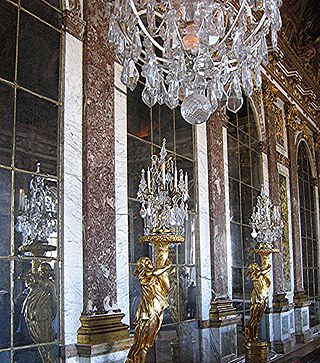Related Research Articles

Marble is a metamorphic rock consisting of carbonate minerals that recrystallize under the influence of heat, pressure and aqueous solutions, most commonly calcite (CaCO3) or dolomite (CaMg(CO3)2) and has a crystalline texture of varying thickness. Marble is typically not foliated (layered), although there are exceptions.

Marble has been the preferred material for stone monumental sculpture since ancient times, with several advantages over its more common geological "parent" limestone, in particular the ability to absorb light a small distance into the surface before refracting it in subsurface scattering. This gives an attractive soft appearance that is especially good for representing human skin, which can also be polished.

Portland stone is a limestone geological formation dating to the Tithonian age of the Late Jurassic that is quarried on the Isle of Portland in Dorset, England. The quarries are cut in beds of white-grey limestone separated by chert beds. It has been used extensively as a building stone throughout the British Isles, notably in major public buildings in London such as St Paul's Cathedral and Buckingham Palace. Portland stone is also exported to many countries, being used for example at the United Nations headquarters in New York City.

Carrara marble, Luna marble to the Romans, is a type of white or blue-grey marble popular for use in sculpture and building decor. It has been quarried since Roman times in the mountains just outside the city of Carrara in the province of Massa and Carrara in the Lunigiana, the northernmost tip of modern-day Tuscany, Italy.
Purbeck Marble is a fossiliferous limestone found in the Isle of Purbeck, a peninsula in south-east Dorset, England. It is a variety of Purbeck stone that has been quarried since at least Roman times as a decorative building stone.

Jerusalem stone is a name applied to various types of pale limestone, dolomite and dolomitic limestone, common in and around Jerusalem that have been used in building since ancient times. One of these limestones, meleke, has been used in many of the region's most celebrated structures, including the Western Wall.

Griotte is a cultural and old trade name given to a type of marbles and limestones. The natural stone is deep cherry-red to brown in colour, often flecked with small dashes of purple and/or spots and streaks of white formed by Goniatites or by later cementation. It is sometimes known as Cannes marble.

Rouge de Rance is a Devonian red reef limestone from the town of Rance in the province of Hainaut.

Noir Belge is collective noun referring to black limestone found on several sites in Belgium. Some trade names refer more specifically to the quarry were the material was found, for example "Noir de Mazy" or "Noir de Golzinne". Some Noir belge marble deposit belongs to a fine-grained calcareous sedimentary formation dated Frasnian era and located on the northern border of Namur sedimentary basin. A few black limestones located in the lower Carboniferous
Noir de Mazy is the only Belgian black (Devonian/Frasnian) limestone that is still exploited today. It is named after the quarry in the Belgian town of Mazy near Gembloux in Wallonia. It is also marketed under the name 'Noir de Golzinne' which is also the trade name of the geological vein that is currently exploited in Mazy.
Noir de Golzinne is the only Belgian black (Devonian/Frasnian) limestone that is still exploited today. It is named after the quarry in the Belgian hamlet of Golzinne near Gembloux in the Walloon Region. "Noir de Golzinne" is also the trade name of the geological vein that is currently exploited in nearby Mazy. The names "Mazy" and "Golzinnes" are often used simultaneously.

Chemtou or Chimtou was an ancient Roman-Berber town in northwestern Tunisia, located 20 km from the city of Jendouba near the Algerian frontier. It was known as Simitthu in antiquity.

Caunes-Minervois is a small medieval town and commune in the Aude department in the Occitanie region in southern France. It is known particularly for its ancient Abbey, dating from the eighth century, and the outstanding red marble that has been quarried locally from Roman times. The name may derive from the ancient local Occitan word for cave, "cauna", of which there are a number in the immediate area.
Golzinne is a hamlet of the village of Bossière in Wallonia. It is administratively part of the city of Gembloux, located in the province of Namur, Belgium.

Ashford Black Marble is the name given to a dark limestone, quarried from mines near Ashford-in-the-Water, in Derbyshire, England. Once cut, turned and polished, its shiny black surface is highly decorative. Ashford Black Marble is a very fine-grained sedimentary rock, and is not a true marble in the geological sense. It can be cut and inlaid with other decorative stones and minerals, using a technique known as pietra dura.

A ledger stone or ledgerstone is an inscribed stone slab usually laid into the floor of a church to commemorate or mark the place of the burial of an important deceased person. The term "ledger" derives from the Middle English words lygger, ligger or leger, themselves derived from the root of the Old English verb liċġan, meaning to lie (down). Ledger stones may also be found as slabs forming the tops of tomb chest monuments.

Naxian marble is a large-crystaled white marble which is quarried from the Cycladic Island of Naxos in Greece. It was among the most significant types of marble for ancient Greece and it continues to be quarried in modern times.
The geology of Belgium encompasses rocks, minerals and tectonic events stretching back more than 500 million years. Belgium covers an area of about 30,507 square kilometers and was instrumental in the development of geology. The extensive outcrops in Belgium became the standard reference points in stratigraphy as early as the mid-19th century. Some of them are internationally recognized features related to the Carboniferous and the Devonian periods. These rocks were folded by two orogeny mountain building events --the Hercynian orogeny, and Caledonian Orogeny. Paleozoic basement rocks cover much of the country and are overlain by Mesozoic and Cenozoic sediments.